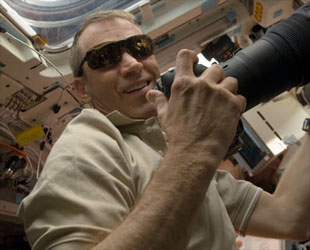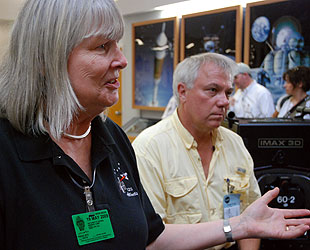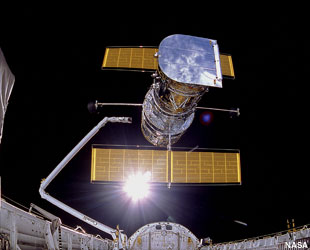May 19, 2009 — Eight pairs of eyes were trained on the Hubble Space Telescope on Tuesday as it was released into orbit after spending a week berthed in space shuttle Atlantis' payload bay. Seven of those stares belonged to the crew of STS-125, who worked to upgrade the satellite during that time.
The eighth captured the view for the rest of us: an IMAX 3D camera.
The 70 mm camera, best known for producing the large format movies that museums and science centers project on giant screens, was flown on the orbiter to document the fifth and final crewed mission to service the telescope for "Hubble 3D", to be released by Warner Brothers in the spring of 2010.
"The main story is to showcase Hubble and its fantastic legacy," described Toni Myers, producer and director of "Hubble 3D", in an interview with collectSPACE. "It's sort of the life of Hubble."
"A big feature of the film will be this repair," she added.
A mile of film in eight minutes
"This is a bigger threat, a bigger challenge, than I had originally thought," admitted STS-125 pilot — and director of photography — Greg C. "Ray Jay" Johnson, during a pre-flight interview with collectSPACE.
"We only have 8 minutes of tape at 30 seconds a whack, so you can screw this up," he observed.

STS-125 pilot Greg "Ray Jay" Johnson on Atlantis. (NASA) |
Given weight constraints, a single, compact 3D camera was flown inside Atlantis' payload bay. Unlike the ground based models that IMAX used to film the crew's training and launch, which employ two rolls of film — one for each "eye" — the orbital version records both left and right eye images on one strip of film.
"What that means," explained Myers, "is to maintain 24 frames a second, it has to go twice as fast. So normal IMAX is 336 feet a minute, so this one is running 672 feet a minute."
The camera holds 5,400 feet, or one mile, of tape but that equates to just 8 minutes, and there's no reloading.
Myers developed a list of about 40 possible scenes that Johnson might capture, ranging from the activities during the mission's five spacewalks to this morning's deploy of the telescope. What she didn't want were posed shots.
"No 'Hello Mom!' kind of scenarios," recalled Johnson.
As it turned out, astronauts hamming it up for the camera was the least of the concerns. Of greater worry was the condition of the camera and the timing of the key mission events.
On the sixth day of the flight, spacewalker Drew Feustel noticed that the window through which the IMAX camera shot from inside its cargo bay enclosure was fogging up.
"Many thanks to Drew for making the catch on the window fog," read the Flight Day 7 IMAX team notes that were uplinked to the crew. "We can't afford to shoot the remaining seconds of film through fog. Checking for fog... before a scene will prevent this."
The daily notes provided other tips for preventing the fog, as well how to better frame and shoot interior crew cabin scenes using HD camcorders that will be converted post flight to 3D.
Mostly though, the team suggested replacement shots as scenes planned for daylight slipped into the night. As the shuttle circles the Earth, it moves in and out of sun every 45 minutes.

"Hubble 3D" director Toni Myers with cinematographer James Neihouse. (collectSPACE) |
"You can't plan for that very rigorously except to know what your back-up is. So every day, I am re-planning if we've lost a shot, how to make it up. It is sort of juggling those 8 minutes," Myers said.
"This is the prime shot of the [fine guidance sensor] but it may be threatened by darkness per the re-planned time line. We very much want this scene. If in real time you see that the install scene is going to be too dark, then we need to shoot the FGS2 removal BEFORE it," instructed a note before the mission's final spacewalk.
Of course, some shots cannot be replaced. Not only was the release of the telescope a pivotal moment in history — it was likely to be the last time astronauts would be within eyeshot of Hubble — it was also the end of the reel.
"You should allow the camera to run out on this one," the note for today began.
Elsewhere in their morning mail, the crew was advised to turn on the lights in Atlantis' cargo hold. "Turning on all possible payload bay flood lights will increase the chance for successful filming," the note explained.
Taking people to the stars
Although Johnson could see what the IMAX camera was seeing using a computer, the results of that last shot and all that preceded it won't really be known until the film can be retrieved after Atlantis lands later this week.

Hubble during its deployment in April 1990, as filmed by an IMAX camera mounted on the shuttle. (NASA) |
And though Myers said her plans are to use every inch shot, she also has a stockpile of footage to pull from. In addition to the scenes shot of the STS-125 crew during the 18 months they were training, she also has IMAX film that was taken in 1990 before and after Hubble launched, as well as footage taken on the first repair flight in 1993.
Some of this earlier film was previously used in the 1994 IMAX 2D movie, "Destiny in Space", said Myers.
"Hubble had only sent back two still images at that point. They were both in the film but they were stills."
"Now we can animate the data and move through it in 3D," Myers explained. "So, it's a marvelous opportunity to really take people to the stars."
In fact, real data from the telescope will be used to create scenes for a third of the completed movie.
"I'm working with the Space Telescope Science Institute on three major sequences," Myers shared. "We'll be able to fly through the Orion Nebula... right through the 'Deep Field' to the edge of time itself."
"Hubble 3D" will be the seventh IMAX film to document space activities and the sixth to include scenes shot on orbit. It's also the second to film NASA astronauts in 3D following the 2002 "Space Station".
"It's great, it's kickin' it up a notch," said Johnson.
